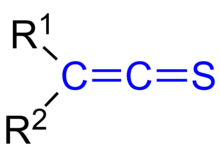Thioketene

The general structure of thioketenes
Thioketenes are organosulfur compounds analogous to ketenes with the general formula R2C=C=S, where R is alkyl or aryl. Thioketene (ethenthione) is also the name of the compound CH2=C=S, which is the simplest thioketene. Thioketenes are reactive, tending to polymerize. Some thioketenes are produced as transient species upon pyrolysis of 1,2,3-thiadiazoles.[1]
Bis(trifluoromethyl)thioketene ((CF3)2C=C=S) is a rare example of a stable thioketene.[2] Another stable thioketene is carbon subsulfide (S=C=C=C=S).
It has been suggested that thioketene could be involved in cell damage processes.[3]
References[]
- ^ Otto-Albrecht Neuman (Editor). Rompps Encyclopedia of Chemistry, Frank'sche Publishing House, Stuttgart, 1983, 8. Edition, p. 4242, ISBN 3-440-04513-7.
- ^ Raasch, Maynard S. (1970). "Bis(trifluoromethyl)thioketene. I. Synthesis and cycloaddition reactions". J. Org. Chem. 35 (10): 3470–3483. doi:10.1021/jo00835a064.
- ^ Dekant, Wolfgang; Urban, Gudrun; Goersmann, Claus; Anders, M.W. (1991). "Thioketene formation from α-haloalkenyl 2-nitrophenyl disulfides: models for biological reactive intermediates of cytotoxic S-conjugates". J. Am. Chem. Soc. 113 (13): 5120–5122. doi:10.1021/ja00013a090.
Categories:
- Sulfur(−II) compounds
- Ketenes
- Functional groups